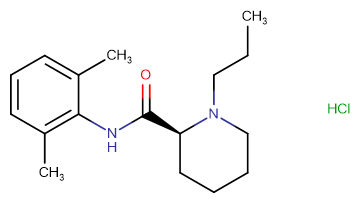
Ropivacaine hydrochloride
CAS No. 98717-15-8
Ropivacaine hydrochloride( —— )
Catalog No. M16897 CAS No. 98717-15-8
Ropivacaine is a local anaesthetic drug belonging to the amino amide group.
Purity : >98% (HPLC)
 COA
COA
 Datasheet
Datasheet
 HNMR
HNMR
 HPLC
HPLC
 MSDS
MSDS
 Handing Instructions
Handing Instructions
| Size | Price / USD | Stock | Quantity |
| 10MG | 35 | In Stock |


|
| 50MG | 57 | In Stock |


|
| 100MG | 83 | In Stock |


|
| 200MG | 120 | In Stock |


|
| 500MG | Get Quote | In Stock |


|
| 1G | Get Quote | In Stock |


|
Biological Information
-
Product NameRopivacaine hydrochloride
-
NoteResearch use only, not for human use.
-
Brief DescriptionRopivacaine is a local anaesthetic drug belonging to the amino amide group.
-
DescriptionRopivacaine is a local anaesthetic drug belonging to the amino amide group. The name ropivacaine refers to both the racemate and the marketed S-enantiomer. Ropivacaine hydrochloride is commonly marketed by AstraZeneca under the trade name Naropin. (In Vivo):Epidural administration of Ropivacaine hydrochloride effectively blocks neuropathic pain (both mechanical allodynia and heat hyperalgesia) without induction of analgesic tolerance and significantly delays the development of neuropathic pain produced by peripheral nerve injury.Ropivacaine hydrochloride inhibits pressure-induced increases in filtration coefficient (Kf) without affecting pulmonary artery pressure (Ppa), pulmonary capillary pressures (Ppc), and zonal characteristics (ZC).Ropivacaine hydrochloride prevents pressure-induced lung edema and associated hyperpermeability as evidence by maintaining PaO2, lung wet-to-dry ratio and plasma volume in levels similar to sham rats.Ropivacaine hydrochloride inhibits pressure-induced NO production as evidenced by decreased lung nitro-tyrosine content when compared to hypertensive lungs.
-
In Vitro——
-
In VivoEpidural administration of Ropivacaine hydrochloride effectively blocks neuropathic pain (both mechanical allodynia and heat hyperalgesia) without induction of analgesic tolerance and significantly delays the development of neuropathic pain produced by peripheral nerve injury.Ropivacaine hydrochloride inhibits pressure-induced increases in filtration coefficient (Kf) without affecting pulmonary artery pressure (Ppa), pulmonary capillary pressures (Ppc), and zonal characteristics (ZC).Ropivacaine hydrochloride prevents pressure-induced lung edema and associated hyperpermeability as evidence by maintaining PaO2, lung wet-to-dry ratio and plasma volume in levels similar to sham rats.Ropivacaine hydrochloride inhibits pressure-induced NO production as evidenced by decreased lung nitro-tyrosine content when compared to hypertensive lungs. Animal Model:Adult Sprague-Dawley rats (300–400g)Dosage:1 μM Administration:Infusion (added to the perfusate reservoir) Result:Attenuated pressure-dependent increases in filtration coefficient (Kf).
-
Synonyms——
-
PathwayMembrane Transporter/Ion Channel
-
TargetSodium Channel
-
RecptorSodium Channel
-
Research Area——
-
Indication——
Chemical Information
-
CAS Number98717-15-8
-
Formula Weight310.86
-
Molecular FormulaC17H26N2O·HCl
-
Purity>98% (HPLC)
-
SolubilityDMSO: 10 mM
-
SMILESCCCN1CCCC[C@H]1C(=O)NC2=C(C=CC=C2C)C.Cl
-
Chemical Name——
Shipping & Storage Information
-
Storage(-20℃)
-
ShippingWith Ice Pack
-
Stability≥ 2 years
Reference
1. Imming P, et al. Nat Rev Drug Discov. 2006, 5(10):821-34.
molnova catalog



related products
-
Solpecainol
solpecainol is a sodium channel blocker used in the study of neurological and cardiovascular diseases.
-
Eslicarbazepine
Eslicarbazepine can be used for adjunctive therapy for adults with partial-onset seizures.
-
Dimethyl lithosperma...
Dimethyl lithospermate B is a selective Na+ channel agonist.



 Cart
Cart
 sales@molnova.com
sales@molnova.com


